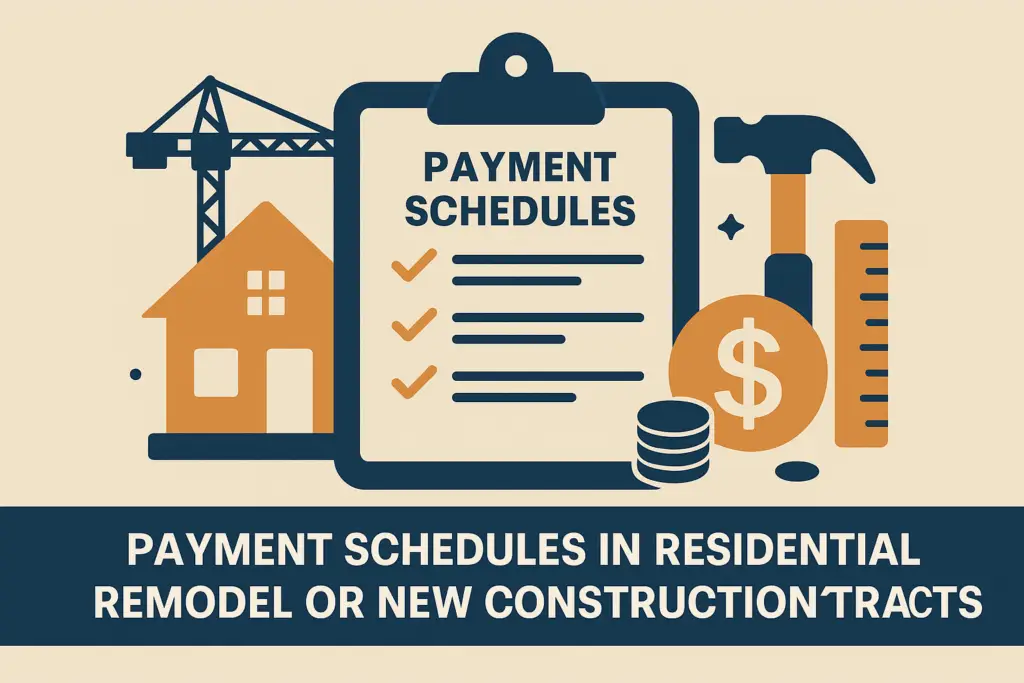When it comes to residential remodeling and new construction in Florida, few issues are more critical — and more contentious — than the payment schedule. A well-structured payment schedule protects both homeowners and contractors, ensuring that the project flows smoothly, disputes are minimized, and work gets completed on time.
As a Florida construction attorney, I’ve reviewed hundreds of contracts and litigated many more where the payment structure was either vague, unenforceable, or ripe for abuse. Below is a detailed look at how to properly structure payment schedules in residential projects and the legal considerations behind them.
Why a Clear Payment Schedule Matters
Florida law doesn’t prescribe a single format for payment schedules, but it does enforce what’s in the contract — and imposes penalties for bad faith or fraud. A clear payment schedule:
- Helps prevent front-loading (overpayment before work is done)
- Reduces the risk of abandonment or disputes
- Aligns with Florida’s construction lien laws
- Ensures funds are released when milestones are truly met
Key Components of a Residential Payment Schedule
Here’s what should be addressed in any payment schedule for a remodel or new construction contract:
1. Deposit / Mobilization Payment
Florida law limits deposits on certain types of work under Florida Statute § 489.126. For residential repair or remodel projects, if the contractor takes more than 10% down, they must apply for permits within 30 days and start work within 90 days. Violations can result in criminal penalties.
Best practice:
- Limit deposit to 10%–20%
- Clearly state what the deposit covers (e.g., permits, design, initial materials)
2. Milestone or Phase-Based Payments
Most residential contracts use milestone-based schedules, which tie payments to completion of specific phases, such as:
- Foundation poured
- Framing complete
- Dry-in (roof/windows)
- Rough-ins (HVAC/plumbing/electrical)
- Inspections passed
- Final punch list
Each milestone should:
- Be objectively verifiable
- Include a sign-off mechanism (written confirmation, photos, inspections)
- Specify the amount due at that stage
3. Retainage
Retainage is a portion (often 5–10%) withheld from each payment or from the final payment to ensure project completion and quality control.
Pros:
- Gives homeowners leverage to ensure punch list items are completed
- Encourages timely finish and attention to detail
Cons:
- May affect contractor cash flow
4. Final Payment Conditions
Final payment should never be automatic. It should require:
- Passing of all final inspections
- Completion of all punch list items
- Waivers of lien from subcontractors and material suppliers
- Delivery of warranties and close-out documents
Common Disputes in Payment Schedules — and How to Avoid Them
- Ambiguous Milestones
If your contract says “50% due halfway through,” what does “halfway” mean? Without objective markers, it invites disagreement.
✅ Fix: Tie payments to physical work completed, not abstract percentages.
- No Written Change Order Policy
Homeowners often request additions or upgrades mid-project — and disputes follow when they’re not documented.
✅ Fix: Require signed written change orders with revised payment terms before performing extra work.
- Front-Loaded Payments
Homeowners who pay 50% before any meaningful work is done are exposed to non-performance or abandonment.
✅ Fix: Ensure payments are proportionate to actual work completed and materials delivered.
How Florida’s Construction Lien Law Interacts with Payment Schedules
Florida Statutes Chapter 713 gives contractors, subs, and material suppliers the right to lien the property if not paid. But payment schedules can affect lien rights in the following ways:
- A proper payment schedule with clear milestones and lien waivers protects owners from double payment.
- If an owner pays ahead of schedule, they may be liable even if the general contractor doesn’t pay their subs.
- Owners should request and review Partial and Final Releases of Lien before issuing milestone or final payments.
Tips for Contractors
- Use standardized progress billing forms or software that tracks completed milestones.
- Clearly outline payment deadlines, late fees, and interest (if allowed).
- Have your contract reviewed by a Florida construction attorney to ensure it complies with lien laws and licensing statutes.
Tips for Homeowners
- Don’t rely on verbal promises — get payment terms in writing.
- Never release final payment until the entire job is complete and lien releases are obtained.
- Ensure your contractor is licensed and pulls permits when required.
Sample Payment Schedule Clause (For Illustrative Purposes Only)
Sample Clause: “The total contract price of $100,000 shall be paid as follows:
- $10,000 deposit upon contract signing
- $20,000 upon completion of foundation and inspection approval
- $20,000 upon completion of framing and roof dry-in
- $20,000 upon completion of rough electrical, plumbing, and HVAC
- $15,000 upon drywall and interior finish installation
- $10,000 upon final inspections and issuance of Certificate of Occupancy
- $5,000 retainage payable 15 days after final punch list completion and delivery of lien waivers and warranty documents.”
Conclusion: Get It Right Before the Work Starts
A payment schedule isn’t just a financial roadmap — it’s a legal safeguard. Both homeowners and contractors benefit when expectations are clear and enforceable. At Andrew Douglas, P.A., we help draft and review residential construction contracts to prevent disputes and protect your rights.
If you’re starting a project or need help resolving a dispute over payments, contact us at andrew@douglasfirm.com or call (954) 474-4420 to schedule a consultation.
